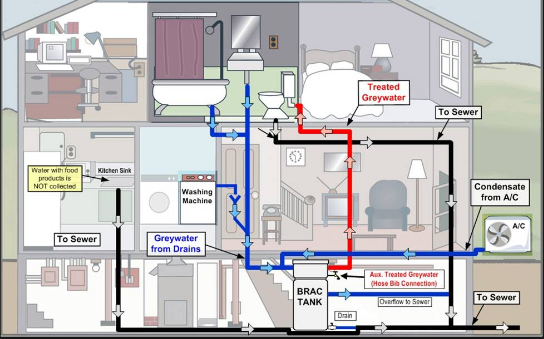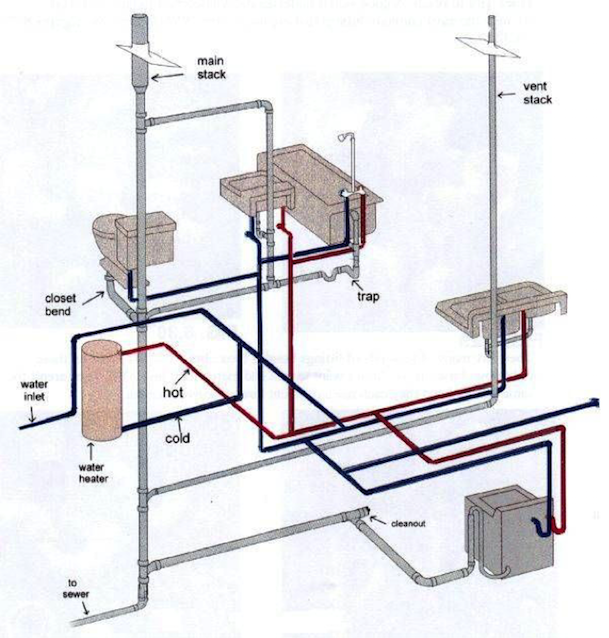This post down the page in relation to Exploring Your Homes Plumbing Anatomy is fairly engaging. Don't miss out on it.

Recognizing how your home's plumbing system functions is essential for every house owner. From providing tidy water for alcohol consumption, cooking, and bathing to safely eliminating wastewater, a properly maintained plumbing system is critical for your family members's health and wellness and convenience. In this thorough guide, we'll explore the detailed network that makes up your home's plumbing and offer suggestions on maintenance, upgrades, and managing usual concerns.
Introduction
Your home's plumbing system is more than just a network of pipes; it's a complicated system that ensures you have access to clean water and reliable wastewater elimination. Recognizing its parts and how they work together can help you prevent expensive repair services and make sure every little thing runs efficiently.
Fundamental Parts of a Pipes System
Pipes and Tubing
At the heart of your pipes system are the pipes and tubing that carry water throughout your home. These can be made from numerous products such as copper, PVC, or PEX, each with its benefits in terms of toughness and cost-effectiveness.
Fixtures: Sinks, Toilets, Showers, etc.
Components like sinks, toilets, showers, and bathtubs are where water is utilized in your home. Comprehending just how these components attach to the plumbing system assists in detecting troubles and intending upgrades.
Shutoffs and Shut-off Factors
Shutoffs manage the circulation of water in your plumbing system. Shut-off valves are important during emergencies or when you need to make repair work, allowing you to separate parts of the system without disrupting water circulation to the whole residence.
Water System
Key Water Line
The main water line links your home to the metropolitan water supply or a personal well. It's where water enters your home and is distributed to numerous fixtures.
Water Meter and Stress Regulatory Authority
The water meter measures your water use, while a stress regulatory authority makes certain that water moves at a safe stress throughout your home's pipes system, protecting against damage to pipes and components.
Cold Water vs. Hot Water Lines
Understanding the distinction in between cold water lines, which provide water directly from the main, and warm water lines, which bring heated water from the hot water heater, assists in fixing and planning for upgrades.
Water drainage System
Drain Pipes Pipeline and Traps
Drain pipes lug wastewater away from sinks, showers, and bathrooms to the sewer or septic tank. Traps stop sewage system gases from entering your home and also catch debris that could create blockages.
Ventilation Pipes
Air flow pipelines enable air into the drainage system, stopping suction that might slow down drainage and trigger catches to vacant. Correct ventilation is crucial for maintaining the stability of your pipes system.
Relevance of Correct Water Drainage
Ensuring appropriate drain prevents backups and water damages. Frequently cleaning drains and keeping catches can prevent pricey repairs and extend the life of your pipes system.
Water Heating Unit
Kinds Of Hot Water Heater
Water heaters can be tankless or typical tank-style. Tankless heaters warmth water as needed, while tanks keep heated water for prompt use.
Upgrading Your Pipes System
Factors for Updating
Upgrading to water-efficient fixtures or replacing old pipes can boost water top quality, decrease water costs, and increase the value of your home.
Modern Pipes Technologies and Their Benefits
Discover modern technologies like smart leak detectors, water-saving toilets, and energy-efficient water heaters that can conserve cash and minimize environmental effect.
Cost Factors To Consider and ROI
Determine the ahead of time expenses versus long-lasting savings when considering pipes upgrades. Many upgrades spend for themselves through minimized utility costs and fewer fixings.
Exactly How Water Heaters Link to the Pipes System
Recognizing how hot water heater link to both the cold water supply and hot water distribution lines aids in detecting issues like insufficient hot water or leaks.
Upkeep Tips for Water Heaters
Regularly flushing your hot water heater to get rid of debris, inspecting the temperature level settings, and checking for leakages can expand its lifespan and enhance power effectiveness.
Typical Pipes Problems
Leakages and Their Causes
Leaks can occur because of maturing pipelines, loosened fittings, or high water pressure. Attending to leaks quickly avoids water damages and mold and mildew development.
Blockages and Obstructions
Blockages in drains and bathrooms are commonly triggered by flushing non-flushable products or an accumulation of grease and hair. Utilizing drainpipe screens and bearing in mind what goes down your drains can avoid blockages.
Signs of Plumbing Problems to Expect
Low tide pressure, slow drains, foul odors, or unusually high water bills are indications of potential plumbing issues that should be attended to immediately.
Plumbing Upkeep Tips
Normal Examinations and Checks
Arrange annual pipes examinations to catch issues early. Seek signs of leaks, deterioration, or mineral build-up in taps and showerheads.
Do It Yourself Maintenance Tasks
Simple jobs like cleansing tap aerators, checking for toilet leakages utilizing color tablet computers, or protecting revealed pipelines in cool environments can stop significant pipes concerns.
When to Call a Professional Plumbing Professional
Know when a plumbing concern calls for specialist know-how. Trying intricate repairs without appropriate understanding can result in more damages and higher repair costs.
Tips for Reducing Water Use
Basic practices like fixing leaks quickly, taking much shorter showers, and running complete loads of laundry and dishes can conserve water and lower your energy bills.
Eco-Friendly Plumbing Options
Consider lasting pipes materials like bamboo for floor covering, which is durable and environment-friendly, or recycled glass for countertops.
Emergency Preparedness
Steps to Take During a Pipes Emergency situation
Know where your shut-off valves lie and exactly how to shut off the supply of water in case of a burst pipeline or significant leak.
Relevance of Having Emergency Contacts Handy
Maintain get in touch with info for regional plumbings or emergency services conveniently offered for quick feedback throughout a plumbing crisis.
Environmental Impact and Preservation
Water-Saving Components and Appliances
Setting up low-flow taps, showerheads, and toilets can considerably reduce water usage without compromising efficiency.
DIY Emergency Fixes (When Relevant).
Temporary repairs like using air duct tape to patch a dripping pipe or positioning a pail under a dripping tap can reduce damage up until a specialist plumber arrives.
Verdict.
Understanding the composition of your home's pipes system empowers you to maintain it successfully, saving money and time on repairs. By complying with normal maintenance routines and staying notified about modern-day pipes modern technologies, you can guarantee your plumbing system operates efficiently for many years to come.
HOW YOUR PLUMBING SYSTEM WORKS
Which Pipes Do What?
Blue lines = fresh water supply entering the building Red lines = hot water supply entering the building Grey lines = pipes carrying waste away from the building and venting pipes carrying gases away from the building (through the roof) YOUR MAIN PLUMBING SYSTEMS
There are two main plumbing systems that support your home s basic plumbing needs one that brings clean water into your home, and one that sends dirty water away from your home. Connected to the toilet, bath, shower, and other faucets in your home, these two systems keep your water flowing in the right directions.
ACCESSING FRESH WATER
Fresh and clean water is brought into your home through the main water supply line . Filtered through one pipe, this water is pressured to flow into the various fixtures in your home at any given time.
This water can be sourced from a well located on your property, a pond or river (mostly cottages), or, as in most cases, from the city s municipal water treatment centre. However, it is important to note that water that is untreated, such as the water siphoned from ponds or rivers, may not be safe to drink. Personal water supplies always need to be treated for hardness and contaminants before consumed.
MUNICIPAL WATER SUPPLIES
Improve taste and odour Remove sediment Eliminate hardness Reduce chlorine COLD WATER SUPPLY VS. HOT WATER SUPPLY
Cold water flows into your home or building through the service line, which then distributes hot or cold water to your fixtures. This line is most commonly run through a central column that runs floor to floor. Hot water runs in short and straight pipes as the longer the pipeline, the more heat that will be lost in the transfer. Having shorter pipes also allows residents to access hot water more quickly.
WASTE WATER SYSTEM
Your wastewater system is divided into two parts pipes that send wastewater away from your home and venting pipes that send sewer gas away from your home. Sewage water travels through pipes that flush the water and waste towards local sewers that are operated and managed by your city or town. Most sewer systems rely on gravity to move the wastewater to where it needs to go.
The further away from your toilet or sink, the larger wastewater pipes become. This allows for waste to be disposed of from various parts of your home or business at once without pipe blockages. The angle and flow of these pipes are also essential for keeping your waste pipes clear of build up.
https://harrisplumbing.ca/how-your-home-plumbing-system-works/

Hopefully you enjoyed our piece on Understanding Your Home's Plumbing Anatomy. Thanks so much for spending some time to browse our piece of content. Loved our post? Please quickly share it. Let others discover it. I am grateful for your time. Don't forget to pay a visit to our website back soon.
About This